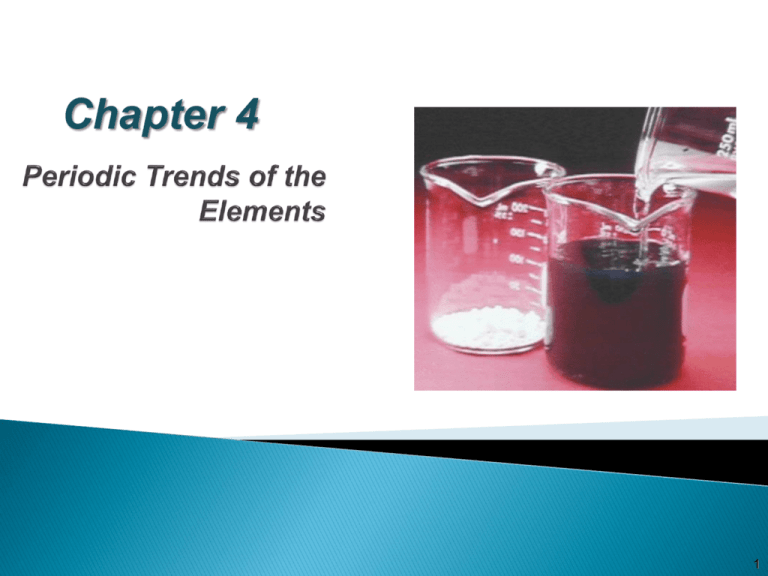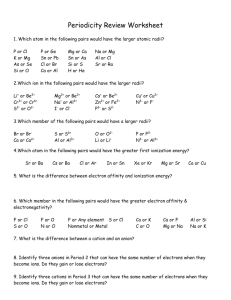Introduction
advertisement

Chapter 4 1 Mid-1800’s, several scientists placed known elements in order based on different criteria. Mendeleev’s and Meyer’s versions, 1869 Anions: simply continue to add electrons in the Aufbau order Write the electron configuration of: FO2N31s2 2s2 2p6 for each These ions are called isoelectronic. 4 Cations: remove electrons in the reverse of the Aufbau order Write the electron configuration of: Al3+ Mg2+ Na+ 1s2 2s2 2p6 These ions are also isoelectronic. 5 Transition metal cations: remove electrons from the s orbital first, then in the reverse Aufbau order Write the electron configurations for: Cr2+ ◦ 1s2 2s2 2p6 3s2 3p6 4s0 3d4 Ti3+ ◦ 1s2 2s2 2p6 3s2 3p6 4s0 3d1 Fe3+ ◦ 1s2 2s2 2p6 3s2 3p6 4s0 3d5 6 Write electron configurations for the following atoms/ions. K (long-hand) S2- (long-hand) Mo (short-hand) Al3+ (long-hand) Fe2+ (short-hand) 7 Atomic Emission Spectra Scarf: http://blog.makezine. com/archive/2010/02 /atomic_emission_spe ctrum_scarf.html Atomic radius can be predicted by looking at elements’ numbers of electrons Definition: one-half the distance between two nuclei in two adjacent atoms 9 Atomic Radii What trends do you notice (left to right; top to bottom)? Why? 10 Effective Nuclear Charge Electrons are all attracted to the nucleus, but electrons in inner shells shield protons and reduce attractive forces of valence electrons. The effective nuclear charge (Zeff) is the amount of positive charge from the nucleus that is perceived by an electron. ◦ In a row (or period) in the Periodic Table, the number of protons increases, but the number of inner e- (shielding e-) stays the same. Atoms on the right side of the Table can pull e- in more tightly. 11 Which element in each pair has a larger atomic radius? Why? F or Cl C or N Rb or Ca Na or Mg K or Na 12 Radius of cation or anion Which gets larger as it goes from atom to ion: cation or anion? Why? Ionic Radii In an isoelectronic series, all ions have the same number of electrons, but the number of protons increases from most negative to most positive ion. Therefore, the radius of the most positive ion is smallest and the most negative ion is largest. Place the following ions in order of increasing ionic radius: Cl1-, K1+, S2-, Ca2+, Al3+, P3- Be2+ or B3+ Al3+ Ca2+ K or or or P3Ca Ca O 2- or F- 16 Be2+ or B3+ Al3+ Ca2+ K or or or P3Ca Ca O 2- or F- 17 Equation representing ionization energy: X(g) X+(g) + eDefine ionization energy: amount of energy required to remove an electron from a neutral atom. Mg Mg+1 IE Defined 18 Ionize Trends 19 Which member of each pair has the larger first ionization energy? Why? F or Cl N or C O or F Na or Mg K or Na 20 Which member of each pair has the larger first ionization energy? Why? F or Cl N or C O or F Na or Mg K or Na 21 Equation representing electron affinity: X(g) + e- X-(g) Define electron affinity: essentially the opposite E- Affinity of the ionization energy: Instead of removing an electron from the element we add an electron to the element to create an anion. Ionization energies are positive values (require input of energy). Electron affinities are negative for most atoms and for all cations. Greater attraction between atom and electron results in more negative EA (e.g., halogens). 22 EA Trends 23 For each periodic trend indicated, identify the atom or ion with a larger value: Radius: Cl or Cl1Radius: O2- or Na1+ Ionization Eng: Na or K Ionization Eng: Ca or Se Electron Affinity: C or F 24 Elements react in order to obtain 8 valence (outermost) electrons. They do this by transferring electrons or sharing electrons. ◦ Metals tend to lose electrons (low I.E.), nonmetals tend to gain electrons (high E.A.). Nonmetal atoms donate electrons to metals to make ionic bonds. Both elements achieve an octet. ◦ Covalent bonds form when elements have to share electrons in order to get 8 valence electrons (an octet) (nonmetals + nonmetals). What do the following have in common? ◦ LiF ◦ CaO ◦ Mg3N2 Look at Ionization Energies and Electron Affinities ◦ Low ionization energy cations ◦ High electron affinity anions Lattice energy: energy required to completely separate one mole of a solid ionic compound into gaseous ions 28 Charges and sizes of ions determine the value of the lattice energy Larger lattice energy more stable crystal stronger ionic bond ◦ Charges are greater, or ◦ Sizes are smaller (lattice energy is inversely related to size) Smaller radii nuclei more strongly attracted to opposite electrons 29 Which compound in each pair is more stable? Is this determined by a high or low lattice energy? ◦ NaCl or MgCl2 Z+ Z◦ MgO or Na2O U = -A d± ◦ NaCl or KCl ◦ NaBr or NaCl 30 Metals tend to react with water to form bases: ◦ 2Na (s) + 2H2O 2NaOH + H2 ◦ MgO (s) + H2O Mg(OH)2 metals Nonmetals tend to react with water to Alkali form + water acids: ◦ 2F2 (g) + 2H2O 4HF + O2 ◦ CO2 (g) + H2O H2CO3 CO2 (s) + H2O (l) H2CO3 (aq)
![The electronic configuration of phosphorus is [Ne] 3s2 3p3](http://s3.studylib.net/store/data/008974852_1-8381577ce936fbfa611892c1a5f109cd-300x300.png)





